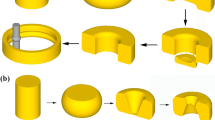Abstract
In this study, a multi-stage warm forging process for making bearing rings is numerically and experimentally investigated. The aim of the study is to determine the crucial station of the finishing forging process such that the tool wear is prolonged and tool fracture should be minimized. In addition, in order to ensure the appropriateness of the suggested modification, a 3-dimensional finite element simulation on each sequence is performed and carefully compared with experimental investigations. Numerical simulation results indicate that the redesigned upper punch geometry, radius (R2) of the finishing forging process, demonstrate drastically different deformation rates (the effective strain/effective stress distribution) and material flow patterns, as compared with chamfer (C2) counterpart. Accuracy of the numerical models has been verified by comparing with experimental measurements. In addition, the numerically and experimentally validated process includes the detailed tooling design and dimension variation, which are of great importance in maintaining the overall structural integrity of the forging die/punch and thus, the stability of the whole process. Concerning on the waste ratio comparison, the method-used steel rods are as raw materials, and the IR/OR ring form is given by hot/warm forging and sequential cold rolling processes, and the waste ratio decreases to ~9 %. Finally, it is shown that the multi-stage warm forging process in this study could be successfully applied to the high-quantity production (10,000 pieces/h) of the IR/OR of the deep groove ball bearing with the stability and structural integrity of the whole process.
Similar content being viewed by others
References
Chao W, Ton B, Edin O, Viktor R, Bert G (2014) Influence of feed rate on damage development in hot ring rolling. Procedia Eng 81:292–297
Ke Y, Ning W, Qiang Z, Yongsheng Z, Jinhua Z, Qingbo N (2015) Theoretical and experimental investigation on the thermal characteristics of double-row tapered roller bearings of high speed locomotive. Int. J. Heat Mass Transf 84:1119–1130
Prasad Y, Rao KP (2011) Materials modeling and finite element simulation of isothermal forging of electrolytic copper. Mater Des 32:1851–1858
Kim EZ, Oh SI, Lee YS, Na KH (2008) Backward can extrusion of ultra-fine-grained bulk Al–Mg alloy fabricated by cryomilling and hydrostatic extrusion. Backward can extrusion of ultra-fine-grained bulk Al–Mg alloy fabricated by cryomilling and hydrostatic extrusion J Mater Process Technol 201:163–167
Kamouneh A, Jun N, Stephenson D, Vriesen R, DeGrace G (2007) Diagnosis of involutometric issues in flat rolling of external helical gears through the use of finite-element models. Int J of Mach Tools and Manuf 47:1257–1262
Kroiß T, Engel U, Merklein M (2013) Comprehensive approach for process modeling and optimization in cold forging considering interactions between process, tool and press. J Mater Process Technol 213:1118–1127
Yuan L, Zhao Z, Shi W, Xu F, Shan D (2015) Isothermal forming of the large-size AZ80A magnesium alloy forging with high mechanical properties. Int J Adv Des Manuf Technol 78:2039–2047
Faraji G, Jafarzadeh H, Jeong HJ, Mashhadi MM, Kim HS (2012) Umerical and experimental investigation of the deformation behavior during the accumulative back extrusion of an AZ91 magnesium alloy. Mater Des 35:251–258
Ku TW, Kang BS (2014) Tool design for inner race cold forging with skew-type cross ball grooves. J Mater Process Technol 214:1482–1502
Lee MC, Chung SH, Jang SM, Joun MS (2009) Three-dimensional simulation of forging using tetrahedral and hexahedral elements. Fin Ele Anal Des 45:745–754
Xinbo L, Hongsheng X, Zhiliang Z (2003) Flow stress of carbon steel 08F in temperature range of warm-forging. J Mater Process Technol 139:543–546
Ou H, Lan J, Armstrong CG, Price MA (2004) An FE simulation and optimization approach for the forging of aeroengine components. J Mater Process Technol 151:208–216
Wan KT, Ho KL, Soo KB (2013) Multi-stage cold forging and experimental investigation for the outer race of constant velocity joints. Mater Des 49:368–385
Ku TW, Kim LH, Kang BS (2014) Process simplification of multi-stage forging for the outer race of a CV joint. Mater Manuf Process 29:85–92
Kang GJ, Kim J, Kang BS (2008) Numerical and experimental evaluation for elastic deformation of a cold forging tool and workpiece for a sleeve cam of an automobile start motor. Mech Eng 222:217–224
Puertas I, Pérez C, Salcedo D, León J, Fuertes JP, Luri(2013) Design and mechanical property analysis of AA1050 turbine blades manufactured by equal channel angular extrusion and isothermal forging. Mater Des 52:885–784
Juan L, Zhenshan C (2009) Hot forging process design and parameters determination of magnesium alloy AZ31B spur bevel gear. J Mater Process Technol 209:5871–5880
Hongchao J, Jinping L, Baoyu W, Zhengrong Z, Tao Z, Zhenghuan H (2015) Numerical analysis and experiment on cross wedge rolling and forging for engine valves. J Mater Process Technol 221:223–242
Duarte M, Martins H (2004) Inner joint forming and pullout simulation using finite element analysis. SAE Tech Paper 01:3422
Chan WL, Fu MW, Lu J (2011) Experimental and simulation study of deformation behavior in micro-compound extrusion process. Mater Des 32:525–534
Murat A, Tekkaya A, Özhan F (2005) Comparison of various preforms for hot forging of bearing rings, journal of materials processing technology. J Mater Process Tech 169:72–82
Lavtar L, Muhič T, Kugler G, Terčelj M (2011) Analysis of the main types of damage on a pair of industrial dies for hot forging car steering mechanisms. Eng Failure Anal 18:1143–1152
Author information
Authors and Affiliations
Corresponding author
Rights and permissions
About this article
Cite this article
Hsu, CC., Huang, JH., Chen, WC. et al. Numerical analysis and experimental validation on multi-stage warm forging process of deep groove ball bearing—a modified punch geometry with microstructure and defect analysis. Int J Adv Manuf Technol 89, 2119–2128 (2017). https://doi.org/10.1007/s00170-016-9218-8
Received:
Accepted:
Published:
Issue Date:
DOI: https://doi.org/10.1007/s00170-016-9218-8



